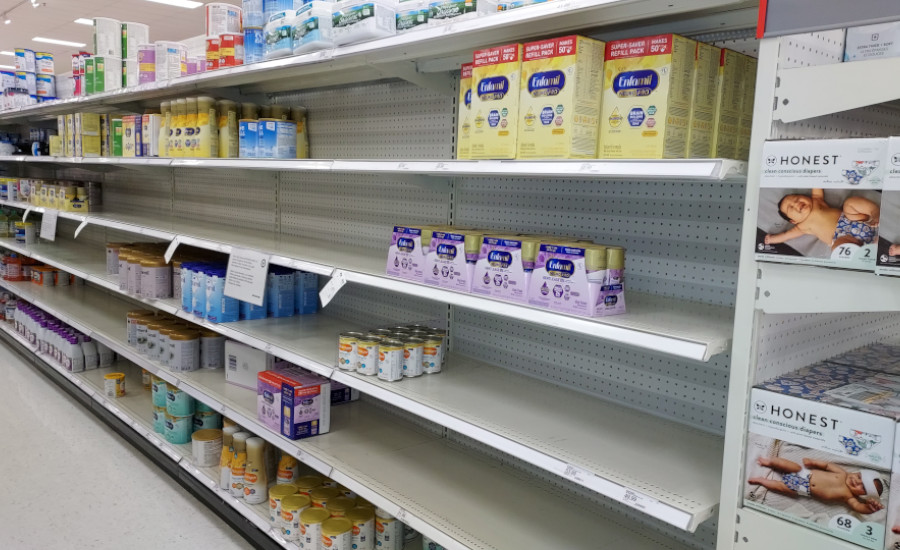Finding infant formula still challenging
Manufacturers continue to ensure the safety of infant formula, while creating a product more like breast milk.

Photo courtesy of Sharon Gerdes.

Nearly three in four babies in the United States will consume infant formula sometime in their first year. For parents of these babies, 2022 was a challenging year. On Feb. 17, Abbott initiated a voluntary recall of certain infant formula powders produced at their Sturgis, Mich., plant. It wasn’t until late August when Abbott restarted infant formula production at their plant. A second Abbott recall occurred in October, this time for certain ready-to-feed liquid formulas, due to a problem with sealing of the bottle caps.
As of this writing, store shelves remain sparsely stocked, and many stores are limiting purchase quantities. Current supply shortages may be due to hoarding, rather than production issues.
More like breast milk
Human milk is the ideal source for infant feeding. But a wide range of circumstances, including return to work, prompt many mothers to supplement with formula or switch entirely to formula sometime during baby’s first year. Infant formula has evolved significantly since 1860, when the first commercial baby food powder was sold in Germany. The Infant Formula Act of 1980 set standards for many nutrients in formulas, and mandates testing and manufacturing standards. Specifications include minimum amounts for 29 nutrients and maximum amounts for nine of those nutrients.
Modern formulas can also include lactoferrin to support immune health; the essential fatty acids DHA and RHA for brain development; up to five human milk oligosaccharides (HMOs) to promote immune support, brain development, and digestive health; and milkfat globule membrane fragments (from whey protein concentrate) to support cognitive development. Specialty formulas are also available for preemies, for babies with milk allergies or sensitivities, and for infants with other special dietary needs. Where parents cannot locate their preferred infant formula, they should reach out to their pediatrician to determine the best alternative product for their child.
Supply update
Abbott, Mead Johnson, and Gerber are the top major brand manufacturers of infant formula. Perrigo, a private-label manufacturer of store brand infant formula in the U.S., recently announced plans to purchase Nestlé’s Gateway plant, increasing its production capacity from 29 million pounds annually to 36 million pounds annually.
John Koval, senior director, public affairs, Abbott provided this update. “We restarted production at Sturgis in July with a focus on our EleCare and other specialty infant formulas. And, in September, we began production of several Similac products at Sturgis, which are reaching shelves shortly. We also boosted production in our global network to increase infant formula supply to the U.S., which includes shipping tens of millions of pounds from our facilities in Europe. Beyond that, we’re working with the USDA and state agencies to provide parents who get formula from the Special Supplemental Nutrition Program for Women, Infants and Children (WIC) with other Similac products and paying rebates for competitive products from other manufacturers. Additionally, we made a $5 million grant to Patient Advocate Foundation (PAF), a national nonprofit organization, to establish a fund to help families with medical and living expenses incurred from the metabolic formula shortage.”
Pathogen control
The gram-negative Cronobacter (Enterobacter) sakazakii was the culprit in the Abbott recall. This foodborne pathogen has caused illness and death in infants and the immunocompromised. Cronobacter, like Salmonella, survives well in dry environments and in low water activity foods like dairy powders. Cronobacter is a vegetative organism that is readily destroyed by pasteurization, so contamination events primarily occur through recontamination of powder in drying, storage, handling, and filling areas.
Dairy processors who want to beef up their plant sanitation can leverage materials developed by experts at processors and co-ops coordinated through the Innovation Center for US Dairy (IC). The IC offers workshops with extensive dry dairy design and sanitation content and has several free resources available, including the publication: “Control of Pathogens: Guidance for the U.S. Dairy Industry.” This publication notes, “These pathogens often enter the plant via raw materials or from human traffic and once present have been widely reported to persist in processing plant niches for years and in some cases decades if proper controls are not in place.”
An Aug. 23, a webinar co-presented by Food Safety magazine and the IC, shared best practices for low-moisture/dry sanitation programs, environmental monitoring, hygienic design, and how to establish and enforce controls for Salmonella and Cronobacter. The next IC-sponsored Dairy Plant Food Safety Workshop will be held February 28-March 1 in Visalia, Calif.
Tim Stubbs of the Innovation Center for US Dairy offers these guidelines to dairy processors to avoid Cronobacter in their plants. “Focus on sanitary design and hygienic controls to keep pathogens out of your facility and away from products; keep the facility and process clean; keep it dry; actively avoid water in dry areas; use environmental monitoring to judge your level of control; and take immediate and aggressive action when you have any deviations.”
Every parent wants what’s best for their baby. Hopefully in 2023, parents will have an easier time finding the infant formula of their choice.
Sharon Gerdes is a certified food scientist and author who writes extensively about dairy’s role in Health and Wellness. Learn more at http://sharongerdes.comLooking for a reprint of this article?
From high-res PDFs to custom plaques, order your copy today!






